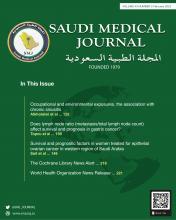Systematic Review
Occupational and environmental exposures, the association with chronic sinusitis
Alkholaiwi et al find smoking is the most aggravating environmental factor in a total of 97 articles were extracted initially, and 15 articles were reviewed after excluding 82 articles that did not match the inclusion criteria. Chronic rhinosinusitis symptoms’ severity increased with direct contact with allergens. Thus, the greatest proportion of patients with chronic rhinosinusitis (CRS) is those with blue-collar occupations, such as firefighters, farmers, and fishermen.
see page 125
Original Articles
Does lymph node ratio (metastasis/total lymph node count) affect survival and prognosis in gastric cancer?
Topcu et al investigate the influence of the metastatic lymph node/total lymph node ratio (N-ratio) on survival and prognosis in surgically treated gastric carcinomas of 73 patients who underwent curative resection. Receiver operating characteristic analysis was used to calculate the cut-off value for the N-ratio of the patients. The mean estimated survival time for the entire group was 40.92 months. This ratio was found to be 0.32, which was statistically significant (p=0.003). Ratios greater than 0.32 raised the risk of mortality by 4.8 times, which was statistically significant (p=0.003). The N-ratio could be a new metric to evaluate prognosis following curative gastrectomy and improve the existing tumor lymph node metastasis staging system.
see page 139
Survival and prognostic factors in women treated for epithelial ovarian cancer in western region of Saudi Arabia
Progression free survival. Kaplan-Meier survival curves of the most significant prognostic factors for disease-free survival in epithelial ovarian cancer.
Sait et al access survival and prognostic factors of 144 women with epithelial ovarian cancer in Western Saudi Arabia. The mean (95% CI) disease-free survival (DFS) was 82.3 (67.8-96.8) months, OS was 96.2 (81.3-111.2) months, and the 5-year survival rate was estimated as 38.9%. Univariate analysis showed that older age, clear cell or papillary carcinoma subtypes, serous type, advanced International Federation of Gynecology and Obstetrics stage and the presence of residual disease were associated with poorer DFS and OS (log rank <0.05). Improving early diagnosis and achieving optimal cytoreduction are the most critical challenges to achieve significant positive impact on survival of women with epithelial ovarian cancer.
see page 146
- Copyright: © Saudi Medical Journal
This is an Open Access journal and articles published are distributed under the terms of the Creative Commons Attribution-NonCommercial License (CC BY-NC). Readers may copy, distribute, and display the work for non-commercial purposes with the proper citation of the original work.







